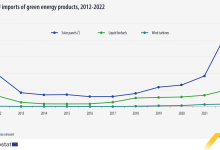Can Romania Function Based on Strategic Planning?
Iulian Harpa is Managing Partner of HiM Public Affairs, a consulting firm operating mainly in the energy sector
The current geopolitical context, which comes immediately after the pandemic crisis, forces us to resort to a comparative analysis to be able to correctly position Romania in the European and global context. And, because here we are talking about energy and funding sources for the projects necessary to develop this sector, I invite you to go through a few chapters together from which to understand pragmatically our achievements, as a country.
Chapter 1: Who claims the best results in Romania’s GDP?
Romania’s Gross Domestic Product was last year EUR 240 billion and accounts for 1.6% of the total GDP of the European Union. To compare, Romania’s GDP has increased by EUR 17 billion compared to the reference year 2019 and, as reference, the strongest economy of Europe, Germany, provided approximately 30% of EU’s GDP!
In terms of public debt, it doubled since 2015, exceeding the threshold of EUR 100 billion, but we still have a good situation, ranking 8th in the EU, in the top of the countries with the lowest debt-to-GDP ratio. Comparatively, the most solid economies in Europe have a much higher indebtedness: Germany 80% and France 130%.
It sounds good, we like it and confidently look to 2040 when, theoretically, if this growth pace is maintained, we will enter the select circle of the top 10 countries in the EU in terms of GDP. When we are presented with these positive figures, no matter who assumes them, we should never forget that the main 2 drivers of this growth are:
- Romania’s membership in the EU (I would also add NATO!) which facilitates direct foreign capital investments and
- The contribution of the private sector in the economy, which has tested its endurance in the last 30 years, going through 2 crises and surviving a climate lacking any form of predictability.
From the perspective of decision-makers that ensured Romania’s management for the past 30 years, Romania ranks 27 in the EU in terms of indicators related to the quality of life, while, from a historical point of view, as a state, we have an area that implicitly gives us the 7th place in Europe!
Chapter 2: A predictable taxation system, adapted to real needs?
VAT & excise duties for fuels
We have all noticed the postponement and decisions made on the fly in terms of energy legislation. We are used to fragmented projects and decisions made without being based on impact studies, addressing effects exclusively, launching the “beneficiary” companies to find realistic solutions to also treat the causes!
Specifically, fuel prices have exploded at the beginning of this year, and this will immediately and directly reflect on inflation; to this end, NBR (National Bank of Romania) has already issued an estimate of around 10%. In this entire time, the European countries have moved fast, 15 European states already deciding to reduce excise duties for fuels for various periods of time (from 2 to 12 months in Malta’s case). Also, others have already decided to lower VAT (the Netherlands and Poland), in the desire to provide fair and competitive prices for the population.
From Romania’s perspective, we have the lowest purchasing power in the EU and an average gasoline price of almost EUR 1.6/litre, the eight lowest price in the EU.
Chapter 3: Capping + compensation + vulnerable consumer =?!?
As extension of the winter protection package, the authorities have issued GEO 27/2022, providing for price capping for consumers for another year, as follows: between RON 0.68/kWh and RON 0.8/kWh for an average monthly electricity consumption and RON 0.31/kWh for gas consumption.
A measure decided again overnight, effective immediately, but which we must admit that we all benefit from and in particular families with low income. Even so, there are some aspects to clarify, and which would have been useful to know:
→ The lack of an information campaign for the population; it is still very difficult to understand all these caps, compensations, the identification of vulnerable consumers and exceptions on energy prices.
→ The question how long the state budget will bear this financial effort remains open; There is no impact study and no transparent presentation of the financial resources to balance the budget until March 2023.
→ There is a real risk, based on the history, that this balance be supported from further taxes applied to the industry!
Example: the renewable industry, where the windfall tax imposed on producers will affect their profitability and the capacity to invest, at a time when energy independence becomes a national goal!
Foreign direct investments will seek in Romania something difficult to find: Predictability. And, if the investors still decide to take the risk to invest in moving sands, they will do it cleverly, pragmatically and in an assumed manner: see the case of Black Sea Oil & Gas.
Chapter 4: Offshore and onshore
All of a sudden, we all want to reduce energy dependence on Russia and one of the natural options is that regarding the exploitation of Black Sea gas. We have a gas production that ensures on average 80% of the needs; it sounds good, but we all know that it is not enough in absence of viable alternative sources!
The new offshore fields were discovered 10 years ago, and the law adopted almost four years ago contains a number of provisions that inhibit investors’ interest in developing the projects. In short, the amendments promised by authorities and postponed are long overdue. Unfortunately, I do not see how the exploration and exploitation of resources can be started in the context of the conflict in the Black Sea area.
Onshore fields are more and more difficult to discover in recent years and the proof are the official reports of OMV Petrom and Romgaz, which confirm annually the decline of oil and gas production. Besides the 2 players active in the market, the decision-makers have failed to attract new important players to support the industry, in great need of new investments in potential fields, at large depths.
The reality tells us that 2 very large investors have already left (the US company ExxonMobil and the Spanish company Repsol) and the other small players are fighting with the accelerated decline of production: Amromco Energy, the third largest gas producer in Romania, has become insolvent!
According to decision-makers, in January 2020 it was intended to organize a new licensing round for 28 blocks (Round XI). The preparation of documents was intended to be completed in mid-February and the notice on the official opening of the round was to be published immediately in the Official Journal of the European Union.
Round XI never took place and it is opportune to mention that the last round (Round X) was held during 2009-2010, when the National Agency of Mineral Resources (NAMR) put up for tender concessions in 30 petroleum blocks, of which 12 onshore and 18 offshore.
Under the current conditions, it is very difficult to understand the lack of decision for both the offshore law and the organization of new tenders for the onshore blocks, which can attract foreign direct investments and can ensure the much-desired energy independence.
Chapter 5: Alternative energy sources?
Before the beginning of the conflict in Ukraine, all the long-term plans of the European Union (EU) and implicitly of Romania regarding the energy future were developed around the European Green Deal and the “Fit for 55” package. But given the new realities, all these will be postponed, at least until Europe ensures alternative energy sources, which confirm the real consumption and adequate prices.
In this case too, the adequate prices can be reached only under the following conditions:
→ The agreements with the United States of America and the Middle East for LNG supply to the EU are operational and commercial
→ The postponement of the plans to close coal-fired power plants
→ The obligation to set up gas stocks for the following winter
→ Increasing energy efficiency by replacing gas-fired power plants without cogeneration
→ Using heat pumps and replacing fossil hydrogen with green hydrogen.
Romania’s move to have 30.7% green energy in total energy mix, by 2030, is an admirable one, but in the short-term renewables are unfortunately too expensive (with storage and high-performance production equipment) to successfully replace constant sources of production.
Chapter 6: Conclusions
Since I returned to Romania (the end of 2013) I have heard people talk, without exception, at profile events, about the national strategy of the energy sector. It will be 10 years in 2023 and probably, as in the case of the Black Sea gas fields, this is the time needed for strategic decisions in Romania.
I refer to it because without the existence of an energy strategy, assumed by the entire political spectrum, any decision made will lack credibility and cohesion. Moreover, in the current political context, they could be obstacles to our common goal: energy independence obtained by boosting domestic production, identifying new supply sources and implicitly the path to predictable energy prices.
In the end, to be able to answer the question whether we can establish the objectives of the energy sector and, implicitly, whether we can work based on a strategy, I believe we do! And I also think we should not only change mentalities and paradigms! More is needed! Perhaps a correct evaluation of the management of the type “job-rotation” within the best performing industry of Romania?







